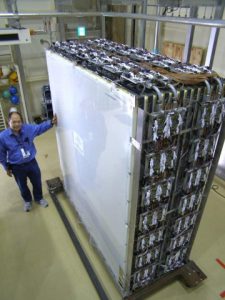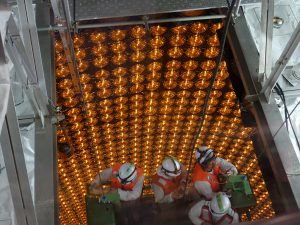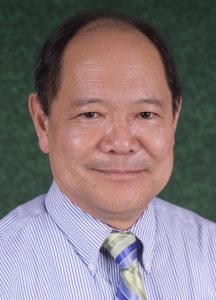 |
Professor A.B., Phi Beta Kappa, Graduated with Great Distinction, University of California, Berkeley (1973) Ph.D., MIT (1976) Fellow of the American Physical Society (2005) Fellow of the Japan Society for the Promotion of Science (2012) CSU group, led by Prof. Toki, shares Breakthrough Prize in Fundamental Physics for T2K Discoveries (2016) Prof. Toki receives CSU Scholarship Impact Award (2017) |
July 21, 2020, First measurement of the charged current anti-muon neutrino double differential cross section on a water target without pions in the final state.
This paper has been published in Physical Review D. The data was taken with the P0D detector in the T2K experiment and measured the anti-muon neutrino cross sections on water. The results confirm that the antineutrino measurements are well understood and modelled in the T2K experiment. This provides ancillary support for the T2K antineutrino measurements used in the search for CP violation. The analysis of the results were from Thomas Campbell’s Phd thesis.
The paper, published by the T2K collaboration, was largely written by Walter Toki.
April 15, 2020, Constraint on the matter-antimatter symmetry-violating phase in neutrino oscillations.
This result has been published in Nature Journal. This paper analyzes the neutrino and the antineutrino electron appearance oscillations observed in the T2K data taken in 2009-2018 and finds a 3 sigma violation of CP conservation. This T2K measurement provides the most significant evidence of CP violation in neutrino vs antineutrino oscillations. It was based on observing 75 neutrino events and 15 antineutrino events at the Super Kamiokande detector. The results are consistent with maximum violation in the PMNS matrix with a CP phase angle of -pi/2. Additional information has been provided in a CSU news release at https://natsci.source.colostate.edu/t2k-experiment-shows-strongest-evidence-yet-of-symmetry-breaking-in-neutrinos/
June 12, 2018, Statistical Significance of CP violation in neutrino oscillation experiments.
The null hypothesis test of CP conservation has been examined in long baseline neutrino oscillations in a paper accepted for publication in Nuclear Instruments and Methods A. The authors are Walter Toki, Thomas Campbell and Erez Reinherz-Aronis.
January 5, 2018, Thomas Campbell passes his Phd oral examination.
Campbell, who was Toki’s thesis student, completed his oral defense on his thesis titled, MEASUREMENT OF THE ANTI-MUON NEUTRINO CHARGED CURRENT – 0 PION DOUBLE DIFFERENTIAL CROSS SECTION ON WATER USING THE P0D-DETECTOR AT T2K EXPERIMENT.
September 5, 2017, Neutrino and Anti-Neutrino Cross Sections published
The CSU analysis of T2K data was published in PhysRevD.96.052001. The analysis was carried out by Erez Aronis-Reinherz, Thomas Campbell and Walter Toki.
April 18, 2017 Prof. Toki awarded the Scholarship Impact Award
The Scholarship Impact Award, given once per year, is one of CSU highest honors given to faculty for important research and scholarship. Highlights of Prof. Toki’s research are given in the link to the award.
August 2016 T2K presents evidence for Charge Parity Violation (CPV)
T2K experiment announces first indications of CPV violation in their recent antineutrino oscillation data when compared to their passed neutrino oscillation data. The rate of Anti-muon neutrinos oscillating into anti-electron neutrinos is smaller than the rate of muon neutrinos oscillating into electron neutrinos. See the CSU news release in Spotlight.
2016 Breakthrough Prize in Fundamental Physics given to T2K Collaboration
This years Breakthrough Prize in Fundamental Physics has been given to five neutrino oscillation experiments including the T2K collaboration. The CSU team, led by Prof. Toki has a 15 member group that worked on the T2K experiment that made these seminal neutrino oscillation measurements. See the list of T2K laureates that include the 15 CSU members, and the description of the award in the Breakthrough Prize , Scientific American, and the New York Times websites.
2015 Nobel Prize in Physics given to Prof. Kajita and Prof. McDonald
This years Nobel prize in Physics has been given for the discovery of neutrino oscillation which prove that neutrin,have different masses by the Super Kamiokande and the SNO Experiments. These exciting physics topics are being continued by the T2K and Nova long baseline neutrino experiments where we expect more fundamental discoveries will be made.
Particle Physics
My current research area is the study of muon neutrino oscillations into electron neutrinos in the T2K experiment in Japan which I joined in 2006. In this experiment, muon neutrino beams from the J-PARC accelerator are sent 295 kilometers underground to the Super-Kamiokande detector (SK) in the Kamioka mine in Japan. The SK experiment is a giant water tank surrounded by photo-multiplier tubes to detect the feeble neutrino interactions. In 2011, before the March 11 earthquake, the T2K experiment observed six candidate muon neutrino events that changed into an electron neutrino while travelling to the SK detector. This was the first indication of muon – electron neutrino oscillations and was published in Physical Review Letters in July 2011. We continued taking new data to improve precision of this measurement. Now, T2K is measuring anti-muon neutrino disappearance and anti-electron neutrino appearance. At CSU we built many parts of the ND280 detector in the T2K experiment which performs as a neutrino beam monitor that measures the flux and cross section rates. We are analyzing the data with U.S. and foreign collaborators.
Please see the CSU – T2K website for details about our CSU work in the T2K collaboration. At CSU, Professors Wilson, and myself collaborate together on the T2K experiment.
In calendar 2012, I worked in Japan on the T2K experiment where I received a Japan Society for the Promotion of Science (JSPS) invitational fellowship hosted by University of Kyoto, Professor T. Nakaya. In Fall 2016 and Spring 2017, a second sabbatical year was taken working on the T2K experiment at the JPARC site.
Currently in the T2K experiment, I am currently a co-convener of the P0D detector, and member of the the T2K International Board, pub-board and authorship committee. In the past I have been, the ND280 Physics and Detector convener, a ND280 run coordinator and shift coordinator, the ND280 on-site supervisor, and a member of the T2K Speakers board, and the T2K election and authorship committees.
My past particle physics research at the BaBar detector at the PEPII electron-positron collider at Stanford Linear Accelerator Center was the study of B mesons and new charmonium states. The BaBar collaboration measured Charge-Parity (CP) violation by observing a difference between the spacial decays of neutral B0 mesons and anti-B0 mesons. These results confirmed the Cabbibo-Kobayashi-Masekawa model which predicted CP violation in the decays of bottom type quarks and this led to 2008 Nobel prize in Physics awarded to the theorists, Kobayashi and Masekawa.
Selected Publications
- Measurement of antineutrino and neutrino charged current inclusive cross sections and their ratio with the T2K off-axis near detector. ARXIV version submitted to Phys. Rev. D, June 26, 2017. The analysis was performed and the paper was written at CSU.
- Combined Analysis of Neutrino and Antineutrino Oscillations at T2K, K. Abe et al. (T2K Collaboration), Phys. Rev. Lett. 118, 151801 – Published 10 April 2017.
- Measurements of neutrino oscillation in appearance and disappearance channels by the T2K experiment with 6.6×1020 protons on target
K. Abe et al. (T2K Collaboration), Phys. Rev. D 91, 072010 (2015) – Published 29 April 2015 - Observation of Electron Neutrino Appearance in a Muon Neutrino Beam
K. Abe et al. (T2K Collaboration) Phys. Rev. Lett. 112, 061802 (2014) – Published 10 February 2014 - Precise Measurement of the Neutrino Mixing Parameter Theta23 from Muon Neutrino Disappearance in an Off-Axis Beam
K. Abe et al. (T2K Collaboration), Phys. Rev. Lett. 112, 181801 (2014) – Published 8 May 2014 - T2K Collaboration, Indication of Electron Neutrino Appearance from an Accelerator-produced Off-axis Muon Neutrino Beam, Phys.Rev.Lett.107:041801,2011.
- T2K Collaboration, First Muon-Neutrino Disappearance Study with an Off-Axis Beam, T2K collaboration, Physical Review D 85, 031103(R) (2012).
- S. Assybekov, et. al., The T2K ND280 Off-Axis Pi-Zero Detector, Nuclear Instruments and Methods in Physics Research A, 686 (2012) 48-63. Description of P0D neutrino detector used in the T2K experiment.
Recent Talks
- Colorado State University, Public Lecture, December 3, 2015, titled, Neutrino Oscillations: Winners of the Nobel and Breakthrough Prizes in Physics, CSU-slides.
- University of Denver, Physics Dept Colloquium, November 4, 2015, titled, Neutrinos and the 2015 Nobel Prize in Physics. UDenver Slides.
- American Physical Society Four Corners Meeting, Tempe, AZ, October 16, 2015. Invited Talk titled, Recent Long Baseline Neutrino Oscillation Results. APS-Tempe-Slides.
Photo Gallery
Click on an image to see a larger view.
Walter Toki at Japan Proton Accelerator Research Center setting up the P0D neutrino detector (2009).
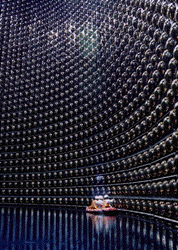
Super Kamiokande Detector in the Kamioka Mine, Japan.
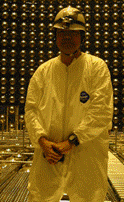
Walter Toki participating on the 2006 repair of the Super K detector .
Entering the SuperK detector from the top in August 2018.
